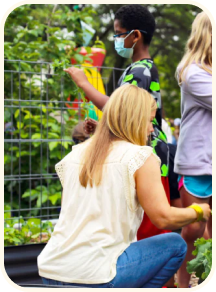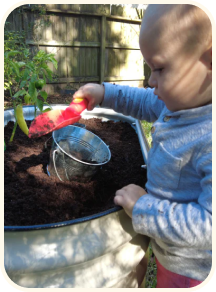The Art of Layering: Understanding Planting Depths in Garden Beds
Perhaps one of the best examples of a layered garden is the English cottage garden, in which flowers and shrubs mingle in lush swaths to create an effusive bloom of color.
Unlike the manicured lawns of America, English gardens are unapologetically wild, with clumps of plants densely knitted together to form a myriad of interesting textures.
While the English garden is often attributed to sprawling manor houses, its techniques can be extrapolated and utilized in both small garden beds and enclosed urban landscapes. Below is a guide that delves into the art of layering plants in garden beds, and the various selections of flowers and shrubs you can grow.
Understand plant depths
Much like the intricate layers of a rainforest, the carefully curated garden bed comprises of several layers. The tallest layer, the canopy layer, consists of tall shrubs and trees, and are placed near the back to form a sturdy backbone. These can also include stouter shrubs such as boxwoods.
Next is the understory, where mid-sized shrubs supplement the taller plants. The groundcover layer acts as the stage: low-lying plants such as creeping thyme are placed in the forefront to elevate and enhance the surrounding foliage.
Keep in mind that these are only general rules to which you can plot out your own garden space. A successful garden relies on rhythm, color coordination and contrast, and an eye for innate beauty. Taller florals don’t need to be relegated to the background; by placing them in the middle, brilliantly colored plants like the striking Alpine Sea Holly can bring an intriguing look to the backyard.
Canopy layer

- Bluestems
- Switch grasses
- Purple Japanese Barberry
- River birch
- Redbud bush
- Pink hair grass
Understory layer

- Lenten Rose ‘New York Night’
- Western Coneflower ‘Green Wizard’
- ‘Brilliant’ Sedum
- Blue Hill Salvia
- Alpine Sea Holly
- English roses
- Yellow blooming verbascum
Groundcover layer

- Creeping phlox
- Creeping thyme
- Candy tuft
- Bearberry cotoneaster
Use trellises and other raised structures
Trellises and other elevated structures can help guide the eye and create a focal point. Although Vego Garden's trellis system is usually intended for vining crops, they are sturdy enough to accommodate dense floriferous vines. Clematis and roses – the classic hallmarks of English gardens – are at once soft and regal, and proliferate over trellises in whimsical profusion, as if straight from the pages of folklore.
Prepare the soil
Before starting, you’ll need to prepare the soil by removing weeds and incorporating organic soil amendments – vital for soil health. Raised garden beds eliminate much of the hassle associated with traditional in-ground beds, which is why they’re so popular with gardeners.
Though mulch remains a neglected aspect of the garden, it is a necessary component in suppressing weeds and retaining moisture. Gardeners focusing on florals and ornamental grasses do not need to be as fastidious as vegetable gardeners, as many will flourish under subpar conditions.
Try these stylish, metal raised garden beds
There is a specific garden bed well-suited for a layered garden, and that is the Cascading Raised Bed. With a two-tiered system, this garden bed allows you to display deeper-rooted plants in the back and shallow-rooted ones in the foreground. For a sleek, modern look, opt for these minimalistic garden beds.
Incorporate a native-themed garden
Some plants thrive on neglect, and this is especially true of a native garden. A native garden is a good way to revitalize a barren yard or neglected spot. Many of these plants are tenacious, having adapted to survive even the most hostile environmental conditions. They are hardy, utilize less water, and are less susceptible to pests. A native garden can come in various variations – a fan favorite is the butterfly garden – but all incorporate native plantings to some extent.
Plant for all seasons
Many gardeners eagerly await the resplendence of summer with little regard for the other seasons. Although summer is where the garden is at its height, it is important that you stagger your plantings for continuous bloom. As with the concept of layering, a grouping of similar plants can quickly become boring. Even the prickly globe thistle and the vigorous honeysuckle will eventually fade, leaving the area bereft come the colder months. To sustain your garden for all seasons, look for long-lived plants that will keep on blooming into fall. If you’re living in the Gulf South, this planting guide can help you plan.
Recommended types of plants to grow
Ambitious gardeners will take into account scent as well as aesthetics of the garden. A few well-placed aromatic flowers can leave the air fragrance with their scent. Don’t be afraid to inject your own personality and tailor your garden towards non-conventional tastes and preferences.
Vining plants: Clematis, honeysuckle, and vining roses are all vining plants that add charm and enchantment to the garden. All of those can be grown in combination, though do make sure to prune them to prevent the trellis or fence from becoming engulfed by their prolific vines.
Goth plants: Far from being seasonal, a goth garden can be a permanent fixture that adds a layer of intrigue. Look out for these darkly-hued varieties: Calibrachoa Black Currant Punch™ Superbells, ‘Black Velvet’ Petunias, ‘Blackout’ Violas.
Ornamental grasses: Ornamental grasses like giant feather grass and pink hair grass are at once delicate and rustic, presenting a rhythmic feel that ties the ensemble together. Scatter ornamental grasses throughout to create varied textual interest.
Companion plants: Notable for their disease-resistance and hardiness, nasturtiums can be trained to climb over trellises – and even living hedges – for a fiery cascade. Like other companion plants, nasturtiums can be grown with an assortment of edible and native plants. Other companion plants include the vibrant marigold, the undemanding calendula, and the stately lavender.
Shrubs: Shrubs are often overlooked, but they can lend much-needed textural interest and brilliance to the garden. From the lavender-like caryopteris to the fragrant mock orange, shrubs provide a welcome complement to low-lying mounds of flowers as they weave among bronze and blue grasses.





























was this written by a bot? useless drivel, mostly. where is the picture?
Nice article but a picture is worth a thousand words.
Leave a comment